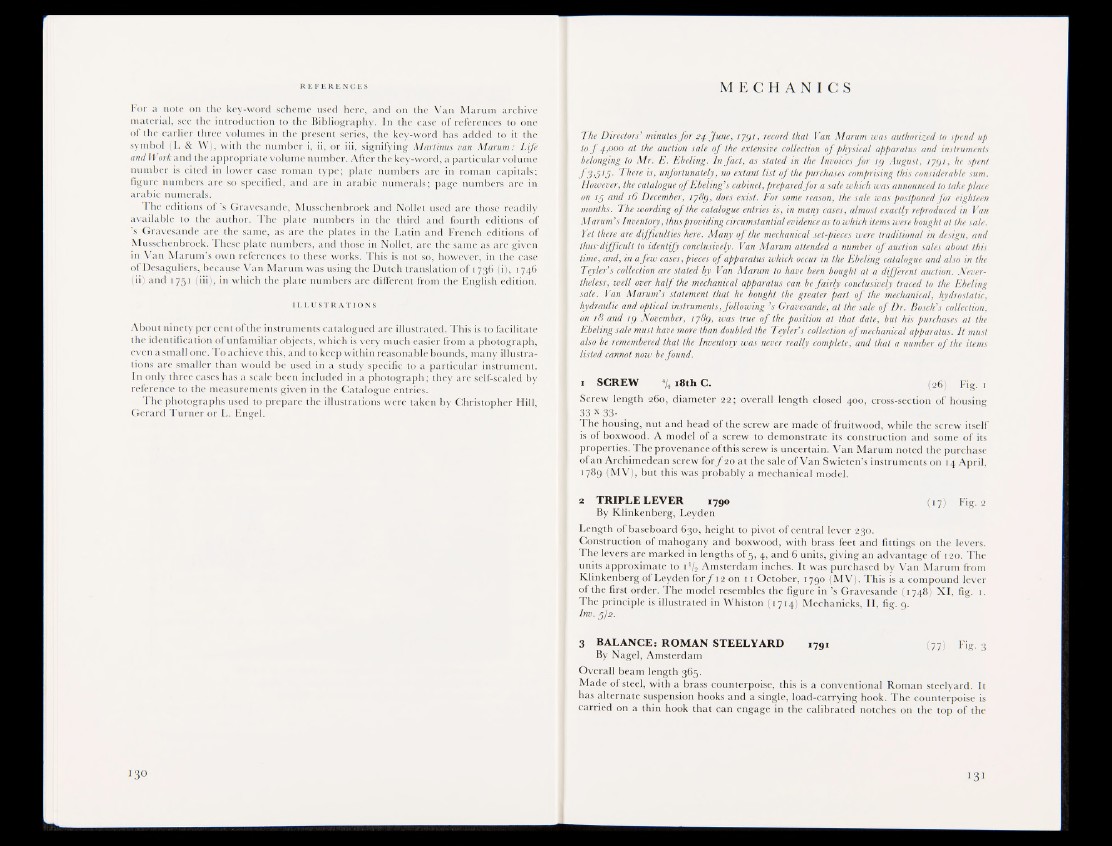
For a note on the key-word scheme used here, and on the Van Marum archive
material, see the introduction to the Bibliography. In the case of references to one
of the earlier three volumes in the present series, the key-word has added to it the
symbol (L & W), with the number i, ii, or iii, signifying Martinus van Marum: Life
and Work and the appropriate volume number. After the key-word, a particular volume
number is cited in lower case roman type; plate numbers are in roman capitals;
figure numbers are so specified, and are in arabic numerals; page numbers are in
arabic numerals.
The editions of ’s Gravesande, Musschenbroek and Nollet used are those readily
available to the author. The plate numbers in the third and fourth editions of
’s Gravesande are the same, as are the plates in the Latin and French editions of
Musschenbroek. These plate numbers, and those in Nollet, are the same as are given
in Van Marum’s own references to these works. This is not so, however, in the case
of Desaguliers, because Van Marum was using the Dutch translation of 1736 (i), 1746
(ii) and 1751 (iii), in which the plate numbers are different from the English edition.
I L L U S T R A T I O N S
About ninety per cent of the instruments catalogued are illustrated. This is to facilitate
the identification of unfamiliar objects, which is very much easier from a photograph,
even a small one. To achieve this, and to keep within reasonable bounds, many illustrations
are smaller than would be used in a study specific to a particular instrument.
In only three cases has a scale been included in a photograph; they are self-scaled by
reference to the measurements given in the Catalogue entries.
The photographs used to prepare the illustrations were taken by Christopher Hill,
Gerard Turner or L. Engel.
The Directors’ minutes for 24 June, iygi, record that Van Marum was authorized to spend up
to f 4,000 at the auction sale of the extensive collection of physical apparatus and instruments
belonging to Mr. E. Ebeling. In fact, as stated in the Invoices for ig August, iygi, he spent
J3>5I5- There is, unfortunately, no extant list of the purchases comprising this considerable sum.
However, the catalogue of Ebeling’s cabinet, preparedfor a sale which was announced to take place
on 15 and 16 December, iy8g, does exist. For some reason, the sale was postponed for eighteen
months. The wording of the catalogue entries is, in many cases, almost exactly reproduced in Van
Marum’s Inventory, thus providing circumstantial evidence as to which items were bought at the sale.
Yet there are difficulties here. Many of the mechanical set-pieces were traditional in design, and
thus-difficult to identify conclusively. Van Marum attended a number of auction sales about this
time, and, in a few cases, pieces of apparatus which occur in the Ebeling catalogue and also in the
Teyler’s collection are stated by Van Marum to have been bought at a different auction. Nevertheless,
well over half the mechanical apparatus can be fairly conclusively traced to the Ebeling
sale. Van Marum’s Statement that he bought the greater part of the mechanical, hydrostatic,
hydraulic and optical instruments, following’s Gravesande, at the sale of Dr. Bosch’s collection,
on 18 and ig November. iySg, was true of the position at that date, but his purchases at the
Ebeling sale must have more than doubled the Teyler’s collection of mechanical apparatus. It must
also be remembered that the Inventory was never really complete, and that a number of the items
listed cannot now be found.
1 SCREW % 18th C. (26) Fig. 1
Screw length 260, diameter 22; overall length closed 400, cross-section of housing
33 x 33.
The housing, nut and head of the screw are made of fruitwood, while the screw itself
is of boxwood. A model of a screw to demonstrate its construction and some of its
properties. The provenance of this screw is uncertain. Van Marum noted the purchase
ofan Archimedean screw for ƒ 20 at the sale of Van Swieten’s instruments on 14 April,
1789 (MVHbut this was probably a mechanical model.
2 TRIPLE LEVER *79® (17) Fig. 2
By Klinkenberg, Leyden
Length of baseboard 630, height to pivot of central lever 230.
Construction of mahogany and boxwood, with brass feet and fittings on the levers.
The levers are marked in lengths of5, 4, and 6 units, giving an advantage of 120. The
units approximate to 1 */j Amsterdam inches. It was purchased by Van Marum from
Klinkenberg of Leyden for ƒ 12 on 11 October, 1790 (MV), This is a compound lever
of the first order. The model resembles the figure in ’s Gravesande (1748) XI, fig. 1.
The principle is illustrated in Whiston (1714) Mechanicks, II, fig. 9.
Inv. 5I2.
3 BALANCE: ROMAN STEELYARD 1791 (77) Fig. 3
By Nagel, Amsterdam
Overall beam length 365.
Made of steel, with a brass counterpoise, this is a conventional Roman steelyard. It
has alternate suspension hooks and a single, load-carrying hook. The counterpoise is
carried on a thin hook that can engage in the calibrated notches on the top of the